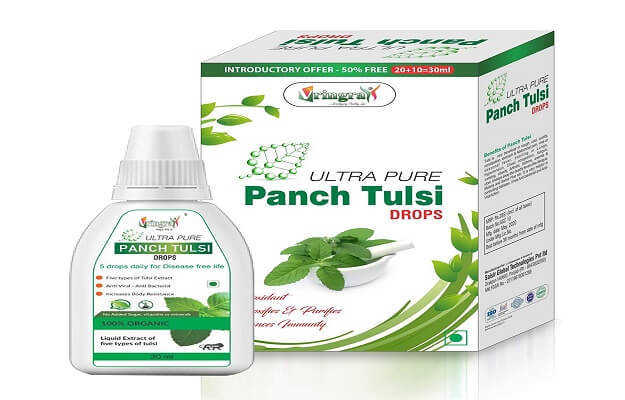98% Savings - Buy Urjas Massage Oil Just @9 Rs
X

- हिं - हिंदी
- En - English
98% Savings - Buy Urjas Massage Oil Just @9 Rs X

Vringra Tulsi Drops is an ayurvedic medicine that is primarily used for the treatment of Common Cold, Cough. Secondary and off-label uses of Vringra Tulsi Drop have also been mentioned below. The key ingredients of Vringra Tulsi Drops are Tulsi. The properties of which have been shared below. The correct dosage of Vringra Tulsi Drops depends on the patient's age, gender, and medical history. This information has been provided in detail in the dosage section.
| Tulsi |
|
Vringra Tulsi Drops is used to treat the following -
Main Benefits
Other Benefits
No side effects of Vringra Tulsi Drops have been reported in the medical literature. However, you should always consult your doctor before using Vringra Tulsi Drops.
Is the use of Vringra Tulsi Drops safe for pregnant women?
There is no side effect of Vringra Tulsi Drops for pregnant women.
Is the use of Vringra Tulsi Drops safe during breastfeeding?
Vringra Tulsi Drops is completely safe for breastfeeding women.
What is the effect of Vringra Tulsi Drops on the stomach?
Using Vringra Tulsi Drops does not have any harmful effects on the stomach.
Is the use of Vringra Tulsi Drops safe for children?
Vringra Tulsi Drops is safe to take for children.
Can I take Vringra Tulsi Drops with alcohol?
No research has been done on this till date. Therefore, it is not known what the effect of taking Vringra Tulsi Drops with alcohol will be.
Does Vringra Tulsi Drops cause drowsiness?
Vringra Tulsi Drops will not make you feel sleepy or drowsy. So you may drive or operate machinery safely.
Is this Vringra Tulsi Drops habit forming or addictive?
There is no evidence on the habit-forming effects of Vringra Tulsi Drops
This medicine data has been created by -

BAMS, Gastroenterology, Dermatology, Psychiatry, Ayurveda, Sexology, Diabetology
10 Years of Experience
References
Ministry of Health and Family Welfare. Department of Ayush: Government of India. [link]. Volume 2. Ghaziabad, India: Pharmacopoeia Commission for Indian Medicine & Homoeopathy; 1999: Page No 170 - 176